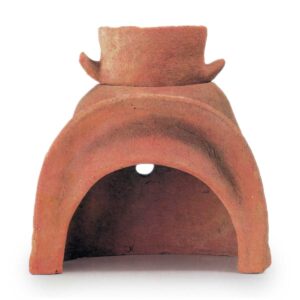
Excavated at Oida, Gose-shi, Nara.
6th century.
Total height 23.0cm (steamer) height 8.9cm, mouth diameter 10.1cm (oven) height 17.5cm, bottom diameter 21.5cm
Nara Prefectural Archaeological Institute of Kashihara Museum
This is a small imitation temporary vessel, probably excavated from a kofun (ancient burial mound). Although it lacks a jar, it was originally a rice cooker consisting of a steamer, a jar, and a kiln. This combination of rice cookers was introduced from the continent in the latter half of the 5th century, around the same time as the introduction of Sue ware production technology, and “han-gama ittogu” in the Shosoin and Engishiki documents probably refers to this type of cooker.
Needless to say, this vessel was buried in a burial mound as a ming vessel, and the custom of burying such a small object is common in burial mounds in the Kinai region during the 6th and 7th centuries. In the first volume of the Kojiki (Records of Ancient Matters), Ijanami-no-mikoto, in an article on Hades, says, “I regret that I did not come sooner. I am going to the Hades. This small model of a burial mound may indicate the custom of the time, when it was believed that one could not return to this world again, of eating food cooked in the electric power of Hades.



